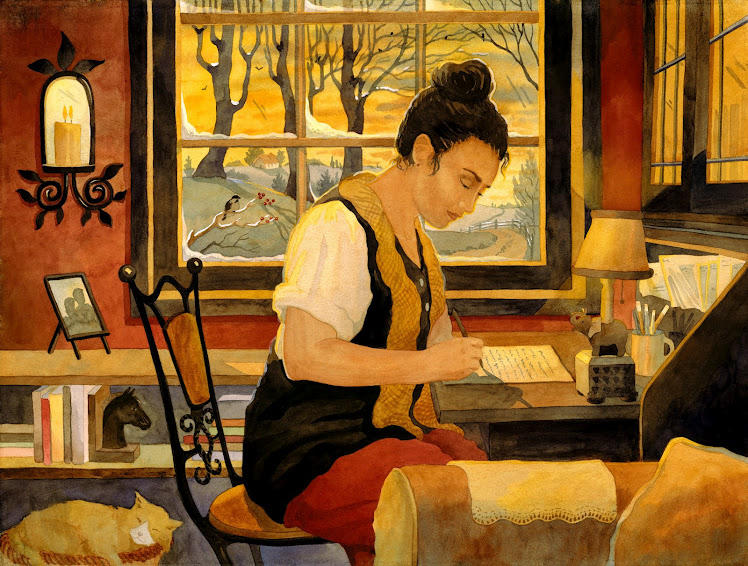Our Writer's Critique Circle has been fortunate to have a screenwriter in our midst for quite awhile. During critique we're assigned parts, and we read from the work-in-progress. Reading a scene aloud can be quite revealing. We're aware when dialogue is too wordy or out of character or off the mark. We sense when a scene "nails it" or when it comes across DOA. And we have a heightened awareness of the overall rhythm and beats in a scene.
Besides reading scenes from fiction aloud to test if we're on the right track, screenwriting techniques offer other ways to make our work better.
What do screenwriters do that the rest of us ought to do?
1) SCREENWRITERS
DON'T WASTE TIME GETTING INTO THE STORY. Since we live in a world of sound
bites, text messages, IM, and emoticons, our readers don't have the patience to
open a book, much less concentrate for long. Therefore, we need to take this
attention deficit disorder into account by making sure there's an emotional
connection right from the beginning.
2) SCREENWRITERS
START SCRIPTS OFF RIGHT. As novel writers, we must revise the first ten pages
over and over and over again. Revision is the only way to get it right. The opening hook is all important. The first few pages of as book can make or break us.
3) SCREENWRITERS
CREATE MEMORABLE HEROES AND VILLAINS. We need to make the protagonist in our
story a fully rounded character and know that fictional person as well as we
know ourselves. This is especially true if the protagonist is the POV narrator.
4) SCREENWRITERS
WRITE ECONOMICALLY. Every line in a screenplay moves the story forward. As
novel writers, we must make sure every scene is there for a reason and not
overwrite. We must delete, kill our "darlings," get rid of "on
the nose" dialogue, and cut lots of backstory. Be like Hemingway. Delete!
5) SCREENWRITERS CREATE GREAT DIALOGUE. We need to make
sure every character in our story has a unique voice. Dialogue shout reveal
character and also move the story forward. Dialogue reveals character and moves the story forward.
5) SCREENWRITERS KNOW
THEIR AUDIENCE As novel writers we need to analyze our readership, the genre
we're writing in, and the type of readers we want to attract. Choosing a few
Beta readers from this group is helpful during revision.
6) SCREENWRITERS UNDERSTAND
THE THREE-ACT STRUCTURE. Novel writers can benefit by having a grasp on story
structure. By page ten, readers want to be introduced to your hero, know what
he or she wants, and feel comfortable in the genre of the story.
By the end of
Act One, readers should have an idea where the story is headed, what the stakes
are, and the obstacles preventing the hero from achieving that goal. By the middle
of Act Two, readers expect the stakes to be raised, a new character introduced ,or
a more difficult obstacle.
By the end of
Act Two, readers predict your hero will be in terrible trouble, backed into a
corner, thrown into a crucible, or caught in the midst of some inescapable
situation, so that the tension builds. In Act Three, readers see the hero to create
a new plan or escape an impossible
situation, and this leads to the big satisfying ending.
7) SCREENWRITERS ARE AWARE OF THEME Not only are they aware of theme, they keep it consistent throughout the script.
Theme is a tough nut
to crack. When I ask my students the theme of Die Hard, they often
restate the film's core concept (or, in Hollywood terms, the
"logline"), saying something like, "It's about a cop thwarting a
group of international terrorists while saving his wife and a bunch of innocent
people." While this is true, it doesn't quite touch on theme.
If we dig
deeper, we discover that Die Hard is really about a man trying to reconnect
with his wife. True, this reconnection takes place amidst the backdrop of an
action-packed heist, but at its core, this is a story about John McClane discovering
the importance of family and the love and appreciation he has for his wife,
Holly.
8) SCREENWRITERS KEEP UP WITH THE CRAFT. They watch and re-watch successful movies that are similar. Audiences want the same, but different. In order to deliver, screenwriters must know the competition and what's out there. As fiction writers, we have an advantage if we're readers, reading successful books similar to our own.
9) SCREENWRITERS KNOW THEIR CHARACTERS. They know what the hero wants, the goal, and what will happen if he doesn't get what he wants (the stakes). They also know what or who is preventing him from reaching that goal (the antagonist or villain). They know how their characters look, talk, act, think. They know the backstory of their characters and know how they will react in situations that occur in the story.
10) SCREENWRITERS LEAVE THE AUDIENCE WANTING MORE. And we should too. JK Rowling certainly did it wit her Harry Potter series and the scripts that followed her novels did the same thing.
How do they do that? Screenwriters create a memorable script with a climactic ending that's satisfying to the audience. The ending is fulfilling, the central problem is resolved, an important character trait is revealed and/or tested, and there's a satisfying surprise toward the end. They create an "aha" moment that makes audiences connect with character and story.
One more thing. They find their tribe. They brainstorm and play with "what if" scenarios. They allow others to offer input and take credit. They often work in a team, ask for help, and they get the job done. All too often, authors are working in isolation and are reluctant to show their work, fearing either rejection or theft.
Let's follow the example of screenwriters, learn from them, and get our job done too.

